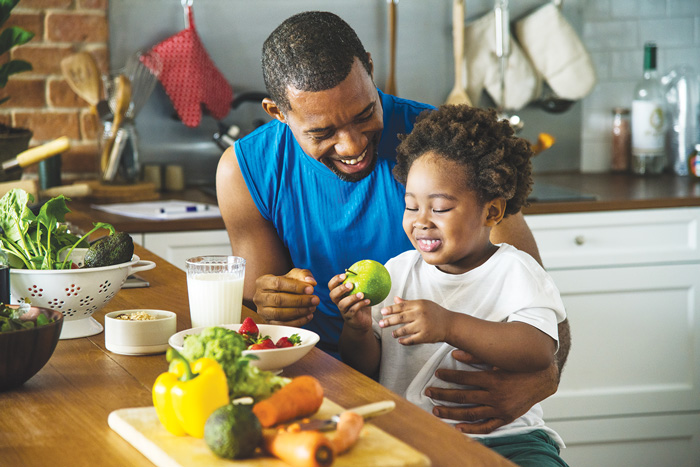IFT20 Scientific Sessions Preview
SCIENTIFIC PROGRAM PREVIEW
IFT20 Scientific Sessions Explore the Power of Plant Protein
Foods and beverages made with plant-based proteins continue to gain mainstream attention, with one quarter of U.S. households regularly eating meat alternatives, according to market research firm Mintel. New launches of plant protein–based products offer consumers a range of options across multiple food and beverage categories. With the growth in popularity of these products, product developers need to understand the ever-changing consumer demands regarding plant-based food and beverage products and the innovations in ingredient developments to help manufacturers formulate products that taste great. That’s why it’s important for food industry professionals to stay up to date on the latest in this area, and there’s no better way than by attending the IFT20 Virtual Annual Event. The scientific sessions will become available July 13–15 and will remain accessible on demand for a year.
Several sessions promise fresh takes and interesting insights from leading experts in the plant-based arena, including market research insights, ingredient innovations, and solutions to product development challenges. Here are a few to put on your calendar now.
To effectively market plant-based products, food companies need to understand who is buying these products and what is influencing the purchasing habits. They also need a sense of consumers’ attitudes toward plant-based protein consumption and products formulated with plant proteins. Two scientific sessions will consider these insights and more. The first, “Personal and Planetary Health: Consumer Perspectives on Plant-Based Protein,” (Session 900) will present insights from three separate consumer research projects from the International Food Information Council. The topics include a look at who is eating plant-based protein products, consumer perspectives toward plant-based protein, and how these perspectives support existing data related to food science, nutrition, and sustainability. The other session, “Plant-Based Protein: A Marketing Dilemma,” (Session 234) will examine the challenges in marketing plant-based protein versus animal-based protein and handling the possible claims for plant-based proteins. Also, details about substantiation requirements and qualifying criteria for various claim categories will be discussed.
Formulating successful plant-based meat alternatives requires special consideration of the types of plant-based ingredients used and how these behave on their own and with other ingredients to affect the overall eating experience. This is especially important as food manufacturers work to develop meat alternatives that look and taste as similar to meat products as possible. Two scientific sessions promise clear guidance on how to overcome formulation challenges regarding the texture, taste, and other attributes of a finished plant-based meat alternative. Experts will provide troubleshooting guidelines and formulating tips to overcome challenges in developing meat alternative products in “Formulating and Troubleshooting for Innovation: What Are the Best Solutions for Meat Alternative Products?” (Session PR 103). Specifically, they will focus on the roles that different types of ingredients have in texture optimization, flavor enhancement/masking, and color development in these products. Another important topic that will be addressed in the session is ensuring the food safety and shelf life in plant protein–based meat alternatives. Most importantly, meat alternative products need to be enjoyable and something that consumers want to purchase again and again. During “Plant-Based Foods: Designing Ingredient, Formulation, and Consumer Opportunities from the Ground Up” (Session PR 102), attendees will learn about the roles that cutting-edge tools such as synthetic biology and physicochemical characterization technique play in developing ingredients for meat alternative products and improving the eating experience of these products for consumers.
Exploring Health and Wellness Topics at the IFT20 Scientific Program
The COVID-19 pandemic has affected every facet of our lives. Home life, social life, work life—everyone has had to make modifications in some or all areas. As such, cooking, eating habits, eating occasions, snacking, and drinking have been altered, which ultimately affects the food industry and how it meets consumer needs and wants.
The pandemic has also affected health and wellness priorities. Some people are watching what they eat to maintain their weight or prevent weight gain during the pandemic. Athletes and fitness buffs may be altering their diets to accommodate for changes in fitness routines and workouts. And top of mind right now for many is immune health. Already there’s been an increased demand for immune-strengthening foods and beverages that contain ingredients like vitamin C, vitamin D, zinc, antioxidants, echinacea, elderberry, and probiotics. This will continue to grow along with an interest in up-and-coming immune ingredients such as yeast beta-glucans, prebiotics, selenium, and non-mainstream botanicals. Additionally, with the expanding body of research linking the gut microbiome, digestive health, and immune health, interest in ingredients that promote healthy microbiomes will also increase.
Scientific sessions within the IFT20 Virtual Event will provide an opportunity to learn about the latest in health and wellness trends that are influencing product development. The sessions will become available during the IFT20 Virtual Event July 13–15 and will remain accessible on demand for a year.
With immune health at the forefront of many consumers’ minds, attendees can educate themselves on the gut microbiome as it relates to digestive and immune health. For a general overview on the topic, there’s Session 119, “Impact of Diet-Microbiota Interactions on Human Health.” The gut microbiota can be modified by exposure to different dietary compounds, which in turn can affect areas like digestion, absorption of nutrients, production of bioactive compounds, and immune health. Information from the session will help attendees understand the ability of foods and nutrients to modulate the gut microbiome. The presenters will elaborate on how microorganisms in the digestive tract metabolize nutrients and the effects on human health.
Another session will address specific ingredients and their effect on the gut microbiome. Session 246, “Under-standing the Benefits of Resistant Starch Fibers and Low-FODMAP Ingredients to Improve Digestive Wellness,” will present information about resistant starch and low-FODMAP (fermentable oligo-, di-, and monosac-charides and polyols) ingredients. FODMAPS are commonly found in fruits, vegetables, legumes, and some nuts. For some people, consumption of FODMAPS contributes to gastrointestinal symptoms. The session will address the use of resistant starch from potato, tapioca, and corn as a low FODMAP ingredient in foods and beverages for populations with gut sensitivity.
Finally, probiotics have evolved into mainstream ingredients as consumers understand their benefits for a healthy gut. Probiotic demand will grow with the desire to strengthen immune systems. Session 129, “Probiotics Paradise: Public Perception, Product, Proof,” will provide an overview of the probiotic market and detail formulation elements and technologies to consider in order to help achieve the desired probiotic populations and benefits in foods and beverages.
The IFT20 Annual Event is a change, but the education and learning opportunities still remain. We look forward to “seeing” you in July and beyond.
Scientific Program Presenters to Address Listeria Control
Listeriosis, caused by Listeria monocytogenes, is the third leading cause of death due to foodborne illness after nontyphoidal Salmonella spp. and norovirus in the United States. Foodborne listeriosis causes about 1,662 cases annually. Approximately 266 individuals who get listeriosis die from it, leading to the troubling fatality/case ratio of 15.9% (Scallan et al. 2011).
L. monocytogenes is different from most other foodborne pathogens. The organism is ubiquitous in nature, resistant to adverse environmental conditions and cold tolerant with an optimum growth temperature of ~25oC. L. monocytogenes grows in human phagocytes; the organism enters the host’s cells, grows inside the cell, and moves into neighboring cells. Moreover, Listeria survives for extended periods of time in/on soil, plants, foods, and food processing surfaces, making Listeria control highly challenging for the food industry. L. monocytogenes grows better in the cold when compared with most other foodborne microorganisms. Therefore, refrigerated ready-to-eat foods pose an exceptional challenge for L. monocytogenes control.
Given the challenges it presents within the food industry, it’s not surprising that Listeria is the subject of a number of poster sessions and symposia that will become available during the IFT20 virtual annual event July 13–15 and will remain accessible on demand for a year.
Listerial Biofilm Control
Biofilms form through accumulation of microbial cells on solid surfaces. Since microbial cells in biofilms are more resistant to adverse environmental conditions (heat, chemicals, sanitizers, etc.) than free individual cells, biofilms pose unique challenges for the food industry. L. monocytogenes forms biofilms on food processing equipment and food surfaces, leading to severe microbial food safety issues.
IFT20 will offer two posters in the area of listerial biofilm control: Brindhalakshmi Balasubramanian will present “Eugenol Nanoemulsion Reduces Biofilm Formation and Inactivates Mature Biofilms of Listeria monocytogenes” as part of ePoster Session 13, “Food Microbiology and Quality Assurance.” And Peter Lee will present “Fractionated Bioactive Compounds of Strawberry Seed Using Ultrafiltration Inhibit Biofilm Formation of Listeria monocytogenes” in Poster Session 4, “Nutraceutical & Functional Foods, Protein and Biotechnology.”
Reducing Listeriosis
As is the case with other foodborne illnesses, reducing listeriosis takes a great deal of time, effort, and collaboration by myriad partners in the food production chain. Chemical antimicrobials, biologically based preservation, and physical methods of food preservation are all used, individually and in combination, to inhibit foodborne pathogens in food processing.
Chlorine in the form of hypochlorous acid is one of the most extensively used sanitizers in the food industry. Chlorine is added to water in the produce industry to transport vegetables and fruits, included in wash waters in food processing facilities, used to sanitize surfaces in food processing facilities, and applied to decrease high microbial loads present on the surfaces of raw meat and poultry. Sodium hypochlorite is highly active against a diverse group of microorganisms and is the most frequently used form of chlorine. The use of chlorine dioxide has significant benefits over sodium hypochlorite. While chlorine dioxide and sodium hypochlorite share similar antimicrobial properties, chlorine dioxide is odorless and also destroys undesirable compounds such as sulfites.
The use of chlorine in the produce industry will be discussed in Poster Session 5, “Food Microbiology and Quality Assurance.” Jyoti Aryal will present research findings on “Efficacy of Chlorine with Wet and Dry Contact Time Against Listeria monocytogenes and Salmonella enterica on Fresh Produce” while Lihan Huang will discuss “Effect of Water Activity and Chlorine Gas Concentration on Inactivation of Listeria monocytogenes in a Model Food System.”
Microbial contamination can originate from numerous areas along the farm-to-table continuum. The preharvest environment is of major significance because microbial contamination of plant tissue can originate from highly diverse sources: irrigation water, soil/soil amendments, meteorological factors, birds, insects, domestic and wild animals, and animal manure. In Poster Session 8, “Dairy Foods, Fruit & Vegetable Products, Foodservice, and International” Vondel Reyes will present on “Evaluation of an Antimicrobial Spray Chilling System for Reducing Listeria on Cantaloupe Surfaces Contam-inated from an Agricultural Setting.”
Biologically Based Preservation
Biologically based preservation methods are among the newer and emerging forms of food preservation. According to Matthews et al. (2017), “biopreservation is the use of lactic acid bacteria (LAB), their metabolic products, or both to improve or ensure the safety and quality of products that are not fermented.” Some LAB produce antimicrobial peptides called bacteriocins, which inhibit foodborne pathogenic bacteria. Nisin is the first characterized LAB bacteriocin and is added as a food safety measure to a variety of foods in the world market, including dairy products, canned foods, salad dressings and sauces, and baby food.
Kefir is a fermented dairy beverage with a typical kefir microbial community that includes LAB, acetic acid bacteria, and yeasts in a symbiotic matrix. Kefir has been shown to contain a variety of natural antimicrobials. In Poster Session 5, “Food Microbiology and Quality Assurance,” Abrar Sindi will discuss “Antimicrobial Activity of Artisanal Kefir Against Salmonella enterica, Staphylococcus aureus, Bacillus cereus, and Listeria monocytogenes.” Alvaro Gustavo Garcia Lira will present findings on “Antimicrobial Effects of Bacteriocins Produced by Lactic Acid Bacteria Against Listeria, Aerobic Bacteria, Yeast, and Mold on Cantaloupe (Cucumis Melo) Surfaces” as part of Poster Session 8, “Dairy Foods, Fruit & Vegetable Products, Foodservice, and International.”
L. monocytogenes has been isolated from fresh, frozen, and processed seafood products. Imitation crabmeat, mussels, shrimp, and rainbow trout have been identified as vehicles for listeriosis. In Poster Session 7, “Carbohydrate; Nutrition; Education, Extension & Outreach; and Nonthermal Processing,” Xue Zhao will present a poster on “The Antimicrobial Effects of Vacuum Impregnated Nisin and Grape Seed Extract on Listeria monocytogenes Inoculated on Tilapia Fillets.”
Physical Methods of Preservation
Animal tissue can be contaminated by L. monocytogenes that might be located inside or outside of food animals. It is challenging to physically remove or kill L. monocytogenes that attaches to raw meat surfaces. While beef-based burgers could be contaminated from various parts of the food animal itself, plant-based burgers could become contaminated through mishandling during processing. Foodborne pathogens such as E. coli, Salmonella, and Listeria are likely to grow more slowly in plant-based products than in meat-based products. In Poster Session 5, “Food Microbiology and Quality Assurance,” John B. Luchansky will discuss “Fate of Shiga Toxin-Producing Escherichia coli, Salmonella, and Listeria monocytogenes Within Plant-Based vs. Beef-Based Burgers in Response to Refrigerated Storage and Cooking.”
Nonthermal Processing
In high pressure processing (HPP), sometimes referred to as “high hydrostatic pressure processing” or “ultrahigh pressure processing,” food products are sealed in pouches, placed in sealed vessels containing water baths, and subjected to high pressure. HPP-treated foods tend not to contain as many additives as their thermally treated counterparts, and they tend to have positive flavor attributes due to the lack of thermally induced undesirable flavors. In scientific program Session 211, organized by Jorge A. Saraiva and titled “Hydrostatic Pressure-Based Processes on the Safety and Quality of Meat Products for Human and Pet Consumption,” Vinicio Serment-Moreno will give a presentation on “Predicting the Survival of Listeria Monocytogenes in High Pressure-Processed Meat Products with the Weibull Model Fit.”
Ultraviolet (UV) light is commonly used to disinfect water and process foods. UV-C light (254 nm) is used for its success as a disinfectant. As part of Poster Session 7, “Carbohydrate; Nutrition; Education, Extension & Outreach; and Nonthermal Processing,” Federico Bueno will present a poster on “Effect of UV-C Light on Microbial and Quality Parameters of Fresh Blueberries (Vaccinium Corymbosum) Inoculated with Listeria innocua B-33016.” Listeria innocua is universally used by many researchers as a nonpathogenic surrogate for L. monocytogenes.
Cold plasma is an emerging food processing method that can be used to sanitize delicate surfaces, such as fresh fruits and vegetables that cannot be thermally processed. In “Innovations in Cold Plasma and Gaseous Chlorine Dioxide as a Waterless Antimicrobial Process for Industrial Use,” the presenters will discuss effective control of human pathogens like Salmonella, Listeria monocytogenes, Escherichia coli O157:H7, norovirus, etc. in various food commodities using cold plasma.
Food Processing Innovation Is on the Virtual Agenda
This year’s IFT20 Virtual Event scientific programming promises to be both exciting and educational, providing a fantastic opportunity to learn about innovations in food processing that are critical to advancing the science of food and feeding the future. The flexibilities afforded through this year’s unprecedented virtual format offer increased options for participating in IFTNEXT sessions, scientific forums, and ePoster sessions—all of which will be available for viewing according to one’s preferred schedule.
For those interested in the intersection between food processing and food disruption, there are several IFTNEXT sessions that promise to be eye-opening, including Session 800, “Creating the Next Big Meat Analogue: An Extrusion Demonstration on Meat Analogue Production,” and Session 904, “Robotics and the Future of the Food Service Industry.”
Nonthermal food processing is a major focus area for this year’s event. Session 110 is titled “Low-Energy Electron Beam as a Cost-Efficient and Sustainable Technology to Deliver High-Quality and Microbiologically Safe Ingredients and Products.” Adverse impacts of thermal food processing on quality and safety will be discussed in Session 120, “Bridging the Gap Between Quality and Safety,” as will nonthermal processing alternatives such as high pressure sterilization, ohmic heating, and ultra short thermal sterilization. Next-generation technologies for controlling biological hazards on fresh produce and other ready-to-eat foods will be reviewed in Session 121, “Innovations in Cold Plasma and Gaseous Chlorine Dioxide as a Waterless Antimicrobial Process for Industrial Use.” Session 211, “Hydrostatic Pressure-Based Processes on the Safety and Quality of Meat Products for Human and Pet Consumption,” will delve further into high pressure processing applications.
Session 217, “Evolution of Selected Nonthermal Food Processing Technologies: A Promise and a Reality,” will provide another opportunity to learn more about nonthermal food processing. The idea for this symposium arose during last year’s 10th anniversary of the IFT Nonthermal Processing Division. It will cover three nonthermal technologies—pulsed electric fields, high pressure processing, and high intensity light—and will include a panel discussion on their advantages, limitations, and future potential.
Applications of ultraviolet light technology and LEDs in food processing will be considered in Session 126, “Bridging Science and Practice to Accelerate Innovation and Integration of Ultraviolet Light Technology and LEDs in Food Processing.” In this session, presenters will discuss the current state of ultraviolet-C technology for treatment of liquid and solid foods, the international regulatory landscape, and steps for additional commercial integration of this method into food processing operations.
Food loss mitigation continues to be a hot issue, and Session 116, “Leveraging Food Value-Chain Sustainability,” will tackle one possible solution through development of innovative microalgae and insect biorefineries, which can capture lost nutrients from bio-waste materials, and the transformation of them into value-added ingredient and protein sources. “Conversion of Food Wastes Into Value-Added Products” is the theme for Session 127. This session will explore increased utilization opportunities for sugar beet, citrus, pineapple, coffee, and other waste streams.
Artificial intelligence, machine learning, and robotics are timely and important food processing topics. Session 101, “False Perspectives of AI and What It Is Capable Of,” will discuss how artificial intelligence and machine learning can be used as tools to predict quality and yield issues in farming, design food manufac-turing facilities, and shorten the product development cycle.
Fermentation technology will be highlighted in Session 239, “Unlocking Fermentation Technology for a Sustainable, Healthy, and Clean Future.” Fermentation has a long history in food processing, and this session will review that history, as well as recent applications and opportunities to combine fermentation technology with other techniques to develop new and improved sustainable food ingredients and products.
The NOVA classification for processed foods will be the topic of Session 104, “The NOVA Disruption: A Call to Action for the Food Industry.” NOVA is a system of classification that can be used to categorize foods into four categories ranging from unprocessed to ultra processed. Criteria for and implications of NOVA will be discussed.
Finally, I would like to call attention to the numerous outstanding and informative ePoster sessions, which cover a wide range of food manufacturing methods, including freeze drying, radio frequency processing, encapsulation, extrusion, isochoric freezing, and many more.
May we welcome with open minds the opportunities to learn in new ways through this year’s virtual IFT scientific program.
Food Packaging Aplenty at IFT20
The role of packaging is essential when it comes to protecting food from deterioration. At IFT20, four scientific sessions will focus on achieving this goal while keeping sustainability in mind. Other packaging-related sessions will address how packaging can be used to support a more sustainable food system, reduce food waste, and add value to the market or consumer experience. These explorations will be among more than 100 virtual on-demand sessions available as part of this year’s scientific program.
Sessions focused on the burgeoning field of sustainable food packaging will include the following symposia.
In Session 207, “Sustainability Assessment in Food Systems: Life Cycle Analysis Principles, Critical Tools, and Recent Advances,” presenters Sergiy M. Smetana with DIL Deutsches Institut für Lebensmitteltechnik; Agnieszka van Batavia, packaging sustainability and regulatory advisor with the LCA Center; Ziynet Boz, assistant professor at the University of Florida; and Claire Sand will discuss the use of LCAs (life cycle analyses) to guide more sustainable packaging decisions.
In session 218, “Single-Use Plastic Packaging for Food and Beverages: Challenges and Opportunities to Achieve Sustainability,” the discussion will focus on sustainable best practices, understanding why recycling plastic is a sustainable practice, and the future of flexible packaging. Presenters will include Maxine Roman, principal scientist, Kraft Heinz; Sandi Childs of the Association of Plastics Recyclers; and Preeta Datta, technical project lead with Sealed Air.
In Session 230, “The Future of Food Packaging: Perspectives on Regulations and Economic Feasibility to Meet Sustainability Goals,” Boz will moderate a discussion among a group of panelists with industry and academic expertise.
In Session 704, Dorota Bartosik, a senior manager with MonoSol, will present an IFTNEXT session titled “Designed to Disappear: The Future of Sustainable Food and Beverage Packaging.” She’ll address the challenge of delivering on consumers’ expectations for convenience while providing eco-friendly solutions.
Sessions in which the focus will be on adding value via packaging include the following symposia.
Session 128, “Packaging Solutions to Prevent Protein Waste From Farm to Retailer,” will be presented by Sand, who is the recipient of the 2020 Riester-Davis-Brody Award, which recognizes lifetime achievement in the packaging discipline.
In Session 230, Sand will share the “Top 10 Science Fusions That Will Shape Food Packaging in the Next Decade.”
In Session 236, “Intelligent Packaging Comes of Age,” food packaging division student representative Sonali Raghunath will moderate a discussion among Ted Labuza, professor at the University of Minnesota; Virpi Korhonen, owner of Packaging Testing and Research; Mohamad Ziyaina of the Tillamook County Creamery Association; and Boz.
Technical Presentations
In IFT20 poster presentations, academics, students, and industry professionals will share research insights in the food packaging arena. Here’s a preview of some of the highlights.
Processing and Packaging Interactions
• “Investigating Biobased and Biodegradable Films for In-Package Thermal Pasteurization”
• “Compounds That Develop in Processed Tomato Products and the Method by Which These Compounds Initiate Corrosion in Metal Cans”
• “Stability of Vitamin C, Color, and Garlic Aroma of Microwave-Assisted Thermally Sterilized Garlic Mashed Potatoes in High Barrier Packaging”
Migration
• “Utilizing TD-GCMS for the Quantitation of Residual Limonene Used as a Natural Solvent in Polyethylene Crystals From Recycled Food Packaging”
Active and Intelligent Packaging
• “Industrially Translatable Active Packaging Technologies Utilizing Reactive Extrusion to Improve Food System Sustainability”
• “Evaluation of Glucono Delta-Lactone Enhancement and Nitrite-Embedded Packaging on Surface and Cooked Color of Dark-Cutting Beef”
• “An Intelligent Packaging System Using a Starch-Based Indicator for Detecting Improperly Preserved Food Items”
• “Combination of Temperature Indicator and Antimicrobial Packaging for Ready-to-Eat Products”
Bio-Derived Packaging
• “Potential of Peach Waste Addition in the Production of Packaging Biocomposites”
• “Controlled Release of Ethyl Formate for In-Packaging Fumigation of Fresh Produce: A Study on Spotted-Wing Drosophila (Drosophila Suzukii) in Blueberries”
• “Performance Assessment of Dicarboxylic Acids as Cross-Linker in Potato Starch-Guar Gum Based Composite Film”
• “Development and Characterization of Hydroxypropyl Methylcellulose or Soy Protein Isolate-Based Edible, Water Soluble, and Antioxidant Sachets for Safflower Oil”
To join the Food Packaging Division leadership team, please contact 2019–2020 chair Maxine Roman ([email protected]), 2020–2021 chair Ziynet Boz ([email protected]), or newsletter editor Chandrashekhar Sonar ([email protected]).
REFERENCES
Matthews, K. R., K. E. Kniel, and T. J. Montville, ed. 2017. Food Microbiology An Introduction, 4th ed. ASM Press.
Scallan, E., R. M. Hoekstra, F. J. Angulo, et al. 2011. “Foodborne illness acquired in the United States—major pathogens.” Emerg Infect Dis. 17(1): 7–15. doi: 10.3201/eid1701.P11101.














